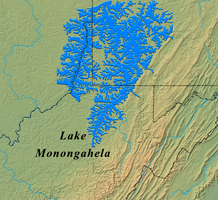
During the Pleistocene Epoch, or Ice Age, mile-thick ice sheets repeatedly covered much of northern North America. Although not themselves reaching present West Virginia, the ice sheets affected the area by damming rivers, temporarily forming large lakes and creating new drainage patterns which persist to the present. Before this time, the ancestral Monongahela River, known to later geologists as the Pittsburgh River, drained what is now northern West Virginia, flowing northward past present Pittsburgh toward Lake Erie and the St. Lawrence River. Lake Monongahela formed when the advancing ice, and later glacial sediments, dammed this river near Pittsburgh.
Lake Monongahela waxed and waned in response to changes in ice volume, stretching as far south as present Weston at its largest but sometimes completely ceasing to exist when the glaciers shrank. It is estimated that Lake Monongahela filled to an elevation near 1,100 feet above sea level. Erosion eventually opened an outlet south of present New Martinsville, draining Lake Monongahela southward into the ancient Teays River watershed, eroding a deep channel and forming the present Ohio River.
The age of Lake Monongahela is based on studies of lake sediments and terrace deposits. The presence of a magnetic polarity switch within the oldest terrace deposits indicates that Lake Monongahela existed initially between 730,000 and 900,000 years ago, since the earth’s polarity is known to have switched during that time. Other terrace deposits indicate much later periods of ponding as glacial sediment choked and dammed the Ohio River.
The oldest sediments are dominated by pollen indicative of a pine-spruce forest. This suggests severe climatic conditions, likely due to the proximity of the ice sheet to the north. Later sediments contain pollen and plant fossils of a hemlock-hardwoods association, suggesting a more moderate climate.
This Article was written by Bascombe M. Blake Jr.
Last Revised on October 07, 2010
Related Articles
Sources
Cross, Aureal T. & Mart P. Schemel. "Geology of the Ohio River Valley in West Virginia," in Aureal T. Cross, et al., eds, Geology and Economic Resources of the Ohio River Valley in West Virginia. Morgantown: West Virginia Geological & Economic Survey, 1956.
Gillespie, William H. & John A. Clendening. A Flora from Proglacial Lake Monongahela. Castanea, (Dec. 1968).
Clendening, John A., John J. Renton & Barbara M. Parsons. "Preliminary Palynological and Mineralogical Analyses of a Lake Monongahela (Pleistocene) Terrace Deposit at Morgantown," Circular C4. West Virginia Geological & Economic Survey, 1967.
Rhodehamel, Edward C. & Charles W. Carlston. "Geologic History of the Teays Valley in West Virginia," Bulletin. Geological Society of America, Mar. 1963.
Cite This Article
Blake Jr., Bascombe M. "Lake Monongahela." e-WV: The West Virginia Encyclopedia. 07 October 2010. Web. 22 October 2024.


Comments?
There aren't any comments for this article yet.
Click here to read and contribute to the discussion →